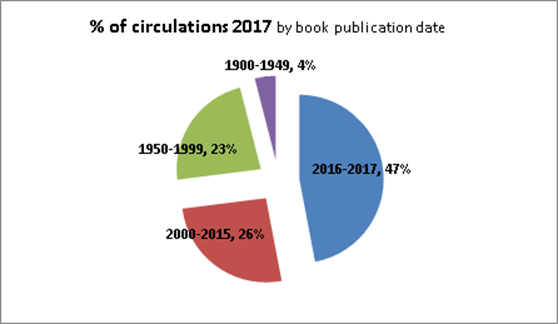What Are We Reading?
As noted in our 2017 Annual Report, the Library circulated about 67,000 print books last year from the adult and children’s collections. Every year, we feature the previous year’s most popular books (and ebooks) on our blog, and you can see 2017’s hit parade here. But what does the long view on circulation statistics, the big picture, reveal about how members use the adult circulating collection over the course of a year? We recently combed through 2017 circulation activity to see, and here is what we found. (Note: This information does not include Children's Library activity.)
Fiction
Our rich fiction collection, housed on stacks five and six plus new books in the circulation area, accounted for about 55% of our adult print circulation in 2017. This won’t be a surprise to most members. We have a truly unique fiction collection: old and new, the canonical and classic, the forgotten and neglected, with deep offerings for the many insatiable mystery readers among the membership.
A scan through the nearly 8,500 novels and story collections that circulated over 2017 is fascinating. Of course, names like Austen, Balzac, Cather, Christie, Dickens, Henry James (42 different  books went out over the year a total of 92 times), Trollope (50 books, 96 checkouts), Barbara Pym, and P.G. Wodehouse appear frequently, but mystery writers are clearly a very important inspiration for members to head into the stacks. Often dismissed by those who don’t read them as ephemeral and disposable, many mystery writers continue to display strong staying power, as members go back and read (and re-read) the voluminous back catalogs of Donna Leon (32 books, 163 checkouts), Margery Allingham, Dorothy Sayers, David Baldacci, Anne Perry, Rex Stout, and many more. The famously prolific Georges Simenon occupies a very impressive patch of real estate in stack 6, and continues to “earn his keep”: Members checked out 69 different books by Simenon 107 times last year.
books went out over the year a total of 92 times), Trollope (50 books, 96 checkouts), Barbara Pym, and P.G. Wodehouse appear frequently, but mystery writers are clearly a very important inspiration for members to head into the stacks. Often dismissed by those who don’t read them as ephemeral and disposable, many mystery writers continue to display strong staying power, as members go back and read (and re-read) the voluminous back catalogs of Donna Leon (32 books, 163 checkouts), Margery Allingham, Dorothy Sayers, David Baldacci, Anne Perry, Rex Stout, and many more. The famously prolific Georges Simenon occupies a very impressive patch of real estate in stack 6, and continues to “earn his keep”: Members checked out 69 different books by Simenon 107 times last year.
Nonfiction
How are members using the rest of the stacks? Biographies (stack 7) and collective biographies (on stack 1) together accounted for the largest share of the nonfiction books that circulated during the year, approximately 27%. Again, no surprise here considering the size and scope of our biography and memoir collection (not to mention the volumes of letters and journals included here). Stack 7 alone includes nearly 28,000 volumes, and we continue to add on average about 360 biographies and collective biographies annually.
After biographies, books in the 900 Dewey decimal classification, housed in stacks 1 and 2 and comprising history and travel, accounted for the second largest share of adult nonfiction circulation in 2017. A closer look reveals that European history (940s) leads the way within the 900s, followed by geography, travel, and exploration (910s), and North American history (the 970s). Books on the World Wars went out 717 times in 2017, and that does not include biographies of war figures, nor books on art or literature related to the wars.
The 800s (poetry, literary criticism, belles lettres, drama, essays, etc.) and the 300s (social sciences) tied for third and fourth place in nonfiction circulation activity. The 300s cover a sprawling territory (economics, sociology, crime, law, military science, espionage, international relations, etc.), so we took a closer look. Books on the social sciences generally—including sociology and anthropology—took the top spot, followed by political science (the 320s, which includes our excellent collection of books on espionage and intelligence), the 360s (social problems, including our fascinating true crime collection), then economics (330s).
Rounding out our Top Five in nonfiction circulation are books on stack 12, the 700s, which includes books devoted to the fine, decorative, and performing arts, plus sports and recreation. General works on the fine and decorative arts (historical treatments, criticism, museum guides, etc.) took first here, followed by painting (750s), film and stage performance (791-793), and music (780s).
Circulation by age of material
Writers, researchers, and readers have long testified to the invaluable resources available in our stacks, praising the opportunities for serendipitous browsing and immediate access to books  consigned to deep (or offsite) storage, or deaccessioned, in other institutions. While books published in 2016-2017—displayed in the circulation area in their shiny new dustjackets to greet members as they come through the door—account for 47% of adult book circulation in 2017, it also true that members still frequently head to the stacks to get what they need. When we isolated the month of November, for example, we found that an average of nearly 80 books from the stacks were checked out daily during the month. In 2017, books published between 2000 and 2015 accounted for about 26% of circulation; 1950-1999, 23%; and 1900-1949, 4%. Books in the stacks published prior to 1900 accounted for a tad less than 1% of circulation. (It is important to note that a 19th-century novel reprinted in 1976 will be recorded as 1976.)
consigned to deep (or offsite) storage, or deaccessioned, in other institutions. While books published in 2016-2017—displayed in the circulation area in their shiny new dustjackets to greet members as they come through the door—account for 47% of adult book circulation in 2017, it also true that members still frequently head to the stacks to get what they need. When we isolated the month of November, for example, we found that an average of nearly 80 books from the stacks were checked out daily during the month. In 2017, books published between 2000 and 2015 accounted for about 26% of circulation; 1950-1999, 23%; and 1900-1949, 4%. Books in the stacks published prior to 1900 accounted for a tad less than 1% of circulation. (It is important to note that a 19th-century novel reprinted in 1976 will be recorded as 1976.)
Next time you are in the building, take the time to have a leisurely, attentive, stroll through the stacks. There is something there for every reader's interest, taste, or mood, and you may find exactly what you didn't know you were looking for. Shirley Hazzard articulated the power of the Society Library stacks beautifully in 2003 at the opening of the Library's 250th anniversary year when she said:
"Of course I regard the Library as a refuge and a treasure house. But I also regard it as a powerhouse. I think it is real life and I fear for people who miss this because they are missing a great energizing force, even something frightening. For instance, when I look at the novels of Thomas Hardy on the shelf, I fear if I see Tess of the d'Urbervilles that I will read it again and have to suffer so much and have to understand so much more than I am willing to understand. These things go on in libraries.
The book is a thing irreplaceable, not because every book is a good book or should even exist, but it is one of the best things invented by man, I would say, and these walls are full of them. A library has to be somewhere where every book can be a potential explosion."


Disqus Comments